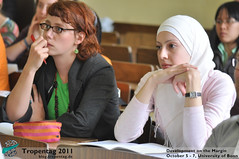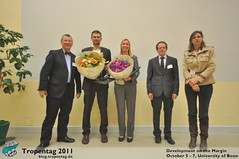De-Registered User's blog
Food and the Arab Awakening
Thu, 10/06/2011 - 16:42 — De-Registered User The capacity to produce sufficient and healthy food to feed its population has become a central issue in most of the middle and low income nations. Food insecurity and poverty go together in most cases. The poor are also the vulnerable. In a study conducted in the highlands of Ethiopia, it was found that the variables (such as education level, age, etc) that play a significant factor in leading to poverty where different from those affecting vulnerability. Nevertheless, the most vulnerable are those caught in the vicious circle of poverty. It was inferred from a research conducted in Tajikistan that the heterogeneity of the effect of food crisis across different household segments (like rural, urban etc) needs to be considered at policy level to create solutions that truly have an impact.
Agricultural Development – The Poverty Exit Strategy
The capacity to produce sufficient and healthy food to feed its population has become a central issue in most of the middle and low income nations. Food insecurity and poverty go together in most cases. The poor are also the vulnerable. In a study conducted in the highlands of Ethiopia, it was found that the variables (such as education level, age, etc) that play a significant factor in leading to poverty where different from those affecting vulnerability. Nevertheless, the most vulnerable are those caught in the vicious circle of poverty. It was inferred from a research conducted in Tajikistan that the heterogeneity of the effect of food crisis across different household segments (like rural, urban etc) needs to be considered at policy level to create solutions that truly have an impact.
Agricultural Development – The Poverty Exit Strategy
“Soil has to be the engine of economic development, use them, improve them and restore them”: Prof. Rattan Lal grants interview
Thu, 10/06/2011 - 12:44 — De-Registered User
A bit of background information about Prof. Lal
Prof. Rattan Lal is a professor of Soil Science in the School of Environment and Natural Resources at the Ohio State University, USA. He has been involved in several activities both in research and teaching. He is a member of the U.S National Committee on Soil Science of the National Academy of Sciences (1998-2002) and (2007-to date). He is the lead author of the Inter-governmental Panel on Climate Change (IPCC) which earned him the Nobel Peace Prize in 2007. Read more about him at http://senr.osu.edu/facview.asp?id=382
Student reporter : What would be your take home message to someone who is not present here at the Tropentag 2011 conference?
Prof. Lal : Several things depend on soil such as food security, water quality, climate change, production and biodiversity. Many ecosystem services which depend on soil are jeopardized because of poor soil management. Taking soils for granted has been the cause of many serious problems and we should avoid it.
Student reporter : How can we achieve good production on marginal soils?
The Meat behind an Enabling Environment
Thu, 10/06/2011 - 12:23 — De-Registered User
Sir Gordon Conway, an Ecologist from the Imperial College London well experienced in development policy, describes an environment with three key challenges for food security.
Challenges for food production.
1. One billion people hungry in the world.
2. A necessity of increasing food production by 70 to 100%.
3. A world price-crisis that still now is causing problems for marginalized people in developing and developed countries.
The higher demand for food is explained by a rising population, an increase in income of some countries with economic growth and energy policies (demand for bio-fuels). On the other hand, degraded lands, degraded water, impact of climate change is negatively affecting food production at a global scale. “Marginalized people are those who own less than 2 hectares of productive land, involving 400-500 million of smallholders, most of them in Asia and Africa.”
 Sir Gordon Conway, Key Note Speaker at Tropentag 2011.
Multiplier effect of agriculture.
Sir Gordon Conway, Key Note Speaker at Tropentag 2011.
Multiplier effect of agriculture.
 Sir Gordon Conway, Key Note Speaker at Tropentag 2011.
Multiplier effect of agriculture.
Sir Gordon Conway, Key Note Speaker at Tropentag 2011.
Multiplier effect of agriculture.
Agriculture and crashing jumbo jets - the first day of Tropentag
Thu, 10/06/2011 - 11:37 — De-Registered User
Looking back on the first day of Tropentag 2011
A ‘hub of discussion’, ‘the most important international conference for the development oriented scientific community’ or just a networking event… with more than 1000 participants from all over the world Tropentag is everything but boring. Looking back on the first day.
‘There are a billion people that are currently hungry. We’ve never had that number of hungry-stricken in the world before. If we’re going to feed the world by 2050 we need to increase food production by something as 70 to 100 percent. The food price spikes are going to recur and food prices will stay high.’ This statement of Sir Gordon Conway (Imperial College) during the plenary speeches on the first day of the Tropentag, will be leading during the whole conference in Bonn. These are the facts. How can research make a contribution to solve this problem?
Questions
As Claudia Mueller (University of Bonn) argued in the opening session of the Tropentag, research on ‘development of the margin’ is needed and should be a guiding principle for all researchers. ‘We will only be successful if we manage to improve the hunger situation for the marginalized in development.’ She raised questions such as how to balance development in favorable and marginal environments? Should marginalized people and communities become key players in an increasingly globalized resource use, and if so, how?
What is Stiftung fiat panis offering to young scientists? Dr. Andrea Fadani answers.
Wed, 10/05/2011 - 23:53 — De-Registered User
Stiftung fiat panis does help to make Tropentag 2011 reality. Dr. Andrea Fadani tells us what else the foundation is doing and which opportunities it is offering to young scientists.
The illusion of marginality
Wed, 10/05/2011 - 19:54 — De-Registered User Marginal people?
No creature is marginal to its own existence. Marginalisation is just a concept incorporated to our “social taxonomy” according to Prof. Paul Richards.
Prof. Paul Richards (Technology and Agrarian Development) from the Wageningen University, argues that in ecology and evolutionary there is no such thing as “marginal people.” Everything has its own place. He argues that the creation of “marginal people” is just a reflection of the human need to classify its environment. It is also a reflection of our capacity to produce insidious harm based on our lack of trust on the others ("I trust myself more than I trust others, I can blame other more than I blame myself").
Prof. Richards argues that in early medieval times most social misfortunes were attributed to the unfitness of the rulers (they were accused for either not being able to do their work or to follow God’s desires), and that rulers were often “marginalised” from common society. This started to change during the later medieval period (the beginning of the market economy), when the blame shifted from elites to certain minorities.
Marginal people?
No creature is marginal to its own existence. Marginalisation is just a concept incorporated to our “social taxonomy” according to Prof. Paul Richards.
Prof. Paul Richards (Technology and Agrarian Development) from the Wageningen University, argues that in ecology and evolutionary there is no such thing as “marginal people.” Everything has its own place. He argues that the creation of “marginal people” is just a reflection of the human need to classify its environment. It is also a reflection of our capacity to produce insidious harm based on our lack of trust on the others ("I trust myself more than I trust others, I can blame other more than I blame myself").
Prof. Richards argues that in early medieval times most social misfortunes were attributed to the unfitness of the rulers (they were accused for either not being able to do their work or to follow God’s desires), and that rulers were often “marginalised” from common society. This started to change during the later medieval period (the beginning of the market economy), when the blame shifted from elites to certain minorities.
Research in Africa Wins Award
Wed, 10/05/2011 - 18:29 — De-Registered User
Andrea Bues and William Leiser win the Hans H. Ruthenberg-Graduate- Award 2011.
 Bues was awarded 2500 Euros for her master thesis work in Ethiopia, which focused on institutional analysis of agricultural foreign direct investment, water rights and conflicts. A student of Humbolt University, Berlin, Bues' research was able examine how access to water resources can contribute to alleviating poverty.
Leiser from University of Hohenheim, won 2500 Euros for his work in Mali. He studied the variation for adaptation of sorghum to low phosphorous soils. His research is an effective contribution towards the reduction of hunger and improvement of food security.
This award is given by the Fiat Panis Foundation. This year's jury members comprised of Prof. Tilman Brueck (Humboldt-University of Berlin), Prof. Ulrike Grote (University of Hannover) and Prof. Joachim Sauerborn (University of Hohenheim). The jury decided the award based on scientific excellence, innovation and applicability.
(By : Priyanka Parvathi and Divya Rajeswari Swaminathan)
Bues was awarded 2500 Euros for her master thesis work in Ethiopia, which focused on institutional analysis of agricultural foreign direct investment, water rights and conflicts. A student of Humbolt University, Berlin, Bues' research was able examine how access to water resources can contribute to alleviating poverty.
Leiser from University of Hohenheim, won 2500 Euros for his work in Mali. He studied the variation for adaptation of sorghum to low phosphorous soils. His research is an effective contribution towards the reduction of hunger and improvement of food security.
This award is given by the Fiat Panis Foundation. This year's jury members comprised of Prof. Tilman Brueck (Humboldt-University of Berlin), Prof. Ulrike Grote (University of Hannover) and Prof. Joachim Sauerborn (University of Hohenheim). The jury decided the award based on scientific excellence, innovation and applicability.
(By : Priyanka Parvathi and Divya Rajeswari Swaminathan)
 Bues was awarded 2500 Euros for her master thesis work in Ethiopia, which focused on institutional analysis of agricultural foreign direct investment, water rights and conflicts. A student of Humbolt University, Berlin, Bues' research was able examine how access to water resources can contribute to alleviating poverty.
Leiser from University of Hohenheim, won 2500 Euros for his work in Mali. He studied the variation for adaptation of sorghum to low phosphorous soils. His research is an effective contribution towards the reduction of hunger and improvement of food security.
This award is given by the Fiat Panis Foundation. This year's jury members comprised of Prof. Tilman Brueck (Humboldt-University of Berlin), Prof. Ulrike Grote (University of Hannover) and Prof. Joachim Sauerborn (University of Hohenheim). The jury decided the award based on scientific excellence, innovation and applicability.
(By : Priyanka Parvathi and Divya Rajeswari Swaminathan)
Bues was awarded 2500 Euros for her master thesis work in Ethiopia, which focused on institutional analysis of agricultural foreign direct investment, water rights and conflicts. A student of Humbolt University, Berlin, Bues' research was able examine how access to water resources can contribute to alleviating poverty.
Leiser from University of Hohenheim, won 2500 Euros for his work in Mali. He studied the variation for adaptation of sorghum to low phosphorous soils. His research is an effective contribution towards the reduction of hunger and improvement of food security.
This award is given by the Fiat Panis Foundation. This year's jury members comprised of Prof. Tilman Brueck (Humboldt-University of Berlin), Prof. Ulrike Grote (University of Hannover) and Prof. Joachim Sauerborn (University of Hohenheim). The jury decided the award based on scientific excellence, innovation and applicability.
(By : Priyanka Parvathi and Divya Rajeswari Swaminathan)
Nobel Prize winner, Prof. Rattan Lal speaks on marginal soils
Wed, 10/05/2011 - 18:20 — De-Registered User
Agriculture is a major contributor to global carbon dioxide emission according to Prof. Rattan Lal, distinguished professor at the Ohio State University, USA who presented on marginal soils at Tropentag 2011 .
He defined marginal soils as “soils of poor quality and characterized by low ecosystem functions and services”. He also underscored the linkages between soils and the ecosystem and spoke about the importance of soil for humanity. He said that when soils get marginalized, people also get marginalized and that when farming occurs, nutrients are removed and these nutrients must be replaced one way or another, otherwise soils then get marginalized. According to him, if the millennium development goals would be achieved, then soils should be taken more seriously and properly protected.
Soil degradation
Land is needed for human settlement especially with population growth and urbanization, and Prof. Lal estimates that up to about 400, 000 ha of land is needed per year for one million people which means that about 3 million ha is converted to areas of human habitation each year. Another cause of soil degradation he mentioned is the use of top soil for brick/block making as well as use of soil for sale. He stated that, “soils can provide for our needs but not our greed”.




